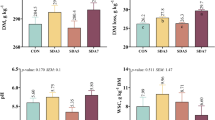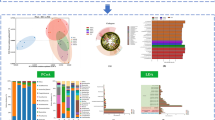Abstract
This study was conducted to evaluate the fermentative profile and microbial populations of wilted and non-wilted alfalfa silages ensiled with or without inoculant and the population dynamics of lactic acid bacteria (LAB) of wilted alfalfa plant and theirs silage. A 2 × 2 × 6 factorial arrangement was used, with the absence or presence of wilting (W), with and without bacterial inoculant (I) and six fermentation periods (P) (1, 3, 7, 14, 28 and 56 days), in a completely randomized design, with three replicates. The alfalfa was slightly wilted for 6 h and increased the dry matter content from 133.9 to 233.4 g/kg. It was performed the cultivation, followed by the isolation of LAB from samples of alfalfa forage before ensiling and its silage only in non-inoculated silages, after different fermentation periods. DNA was extracted from the isolated strains of LAB; the 16S rRNA gene sequences were amplified by PCR and the sequences were compared to those available from the GenBank database. Wilting provided silages with lower pH, ammonia nitrogen and acetic acid concentrations. The wilting process did not alter the amount of LAB; however, it affected the LAB diversity of the silages. The Lactobacillus plantarum was the predominant species in non-wilted and wilted silages.



Similar content being viewed by others
References
Bao W, Mi Z, Xu H, Zheng Y, Kwok LY, Zhang H, Zhang W (2016) Assessing quality of Medicago sativa silage by monitoring bacterial composition with single molecule, real-time sequencing technology and various physiological parameters. Sci Rep 6:28358
Borreani G, Tabacco E, Schmidt RJ, Holmes BJ, Muck RE (2018) Silage review: Factors affecting dry matter and quality losses in silages. J Dairy Sci 101 (5)
Bridge PD, Sneath PHA (1982) Streptococcus-gallinarum Sp-Nov and Streptococcus-oralis Sp-Nov. Intern J Systematic Bacteriol 32:410–415
Cai Y, Benno Y, Ogawa M, Ohmomo S, Kumai S, Nakase T (1998) Influence of Lactobacillus spp. from an inoculant and of Weissella and Leuconostoc spp from forage crops on silage fermentation. Appl Environ Microbiol 64:2982–2987
Chahrour W, Merzouk Y, Henni JE, Haddaji M, Kihal M (2013) Screening and identification of lactic acid bacteria isolated from sorghum silage processes in west Algeria. Afr J Biotechnol 12(14):1703–1709
Danner H, Holzer M, Mayrhuber E, Braun R (2003) Acetic acid increases stability of silage under aerobic conditions. Appl Environ Microbiol 69(1):562–567
Deriaz RE (1961) Routine analysis of carbohydrate and lignin in herbage. J Sci Food Agric 12:150–160
Fenton MP (1987) An investigation into the sources of lactic acid bacteria in grass silage. J Appl Bacteriol 62:181
Fusco V, Quero GM, Cho GS, Kabisch J, Meske D, Neve H, Bockelmann W, Franz CMAP (2015) The genus Weissella: taxonomy, ecology and biotechnological potential. Front Microbiol 6:155
Graf K, Ulrich A, Idler C, Klocke M (2016) Bacterial community dynamics during ensiling of perennial ryegrass at two compaction levels monitored by terminal restriction fragment length polymorphism. J Appl Microbiol 120
Hartmann M, Windmer F (2006) Community structure analysis are more sensitive to differences in soil bacterial communities than anonymous diversity indices. Appl Environ Microbiol 72:7804–7812
Heuer H, Krsek M, Baker P, Smalla K, Wellington EMH (1997) Analysis of Actinomycete communities by specific amplification of genes encoding 16S rRNA and gel-electrophoretic separation in denaturing gradients. Appl Environ Microbiol 63:3233–3241
Holt JG, Krieg NR, Sneath PHA (1994) Bergey’s manual of determinative bacteriology, 9th edn. Williams and Wilkins, Baltimore
Koeuth T, Versalovic J, Lupski JR (1995) Differential subsequence conservation of interspersed repetitive Streptococcus pneumoniae Box elements in diverse bacteria. Genome Res 5:408–418
Lin C, Bolsen KK, Brent BE, Hart RA, Dickerson JT (1992) Epiphytic microflora on alfalfa and whole-plant corn. J Dairy Sci 75:2484–2493
Liu Q, Chen M, Zhang J, Shi S, Cai Y (2012) Characteristics of isolated lactic acid bacteria and their effectiveness to improve stylo (Stylosanthes guianensis Sw.) silage quality at various temperatures. Anim Sci J 83:128–135
Mahanna B, Chase LE (2003) Practical application and solution to silage problems. In: silage science and technology, Proceedings. Madison: ASCSSA-SSSA, Agronomy 42:31–93
Mahanna WC (1993) Silage fermentation and additive use in North America. In: Silage production from seed to animal, Proceedings, New York, NRAES, 85–95
Mayra-Makinen A, Bigret M (1998) Industrial use and production of lactic acid bacteria. In: Lactic Acid Bacteria – Microbiology and Functional Aspects, 2nd edn. Marcel Dekker, New York, pp 73–102
McDonald P, Henderson AR, Heron SJE (1991) Biochemistry of silage, 2.ed. Marlow Chalcombe Publications, New York, p 340
Monteiro ALG, Costa C, Arrigoni MB (1998) Evaluation of Potential for Ensiling Alfalfa Cultivars (Medicago sativa L.) (In Portuguese). R Bras Zootec 27(5):1064–1068
Muck RE (1988) Factors influencing silage quality and their implications for management. J Dairy Sci 71:2992–3002
Muck RE (1989) Initial bacterial numbers on lucerne prior to ensiling. Grass Forage Sci 44:19
Nishino N, Li Y, Wang C, Parvin S (2012) Effects of wilting and molasses addition on fermentation and bacterial community in guinea grass silage. Lett Appl Microbiol 54:175–181
Ogunade IM, Jiang Y, Pech Cervantes AA, Kim DH, Oliveira AS, Vyas D, Weinberg ZG, Jeong KC, Adesogan AT (2018) Bacterial diversity and composition of alfalfa silage as analyzed by Illumina MiSeq sequencing: Effects of Escherichia coli O157:H7 and silage additives. J Dairy Sci 101:2048–2059
Ouwehand A, Salminen S, Isolauri E (2002) Probiotics: an overview of beneficial effects. Antonie Van Leeuwenhoek 82:279–289
Pahlow G, Muck RE, Driehuis F, Oude-Elferink SJWH, Spoelstra SF (2003) Microbiology of Ensiling. Silage Science Technology 42:31–93
Playne MJ, McDonald P (1966) The buffering constituents of herbage and of silage. J Sci Food Agric 17:264–268
Rangrab LH, Mühlbach PRF, Berto JL (2000) Alfalfa silage harvested at the beginning of flowering and subjected to wilting and the action of biological additives (in Portuguese). R Bras de Zootec 29(2):349–356
Ruser B (1989) Erfassung und Identifizierung des epiphytischen Micbsaure-bakterienbesatzes auf Gras und Mais in Abblingigkeit von Standort, Sorte, Entwicklungsstadium Sowieemte-und Klimaeinflussen. Dissertation Institute for Grassland and Forage Research
Schachtsiek M, Hammes WP, Hertel C (2004) Characterization of Lactobacillus coryniformis DSM 20001T surface protein Cpf mediating coaggregation with and aggregation among pathogens. Appl Environ Microbiol 70:7078–7085
Siegfried VR, Ruckemann H, Stumpf G (1984) Eine HPLC-Methode zur Bestimmung organischer Säuren in Silagen. Landwirtsch Forsch 37:298–304
Stevenson DM, Muck RE, Shinners KJ, Weimer PJ (2006) Use of real time PCR to determine population profiles of individual species of lactic acid bacteria in alfalfa silage and stored corn stover. Appl Mircrobiol Biotechnol 71:329–338
Tagg JR, Dajani AS, Wannamaker LW (1976) Bacteriocins of gram-positive bacteria. Bacteriol Rev 40:722–756
Tanaka O, Komatsu T, Oshibe A, Cai Y, Miyazaki S, Nakanishi K (2009) Production of 3-hydroxypropionaldehyde in silage inoculated with Lactobacillus coryniformis plus glycerol. Biosci Biotechnol Biochem 73:1494–1499
Tanaka O, Mori K, Ohmomo S (2000) Effect of inoculation with Lactobacillus curvatus on ensiling. Grassland Sci 46:148–152
Tanasupawat S, Shida O, Okada S, Komagata K (2000) Lactobacillus acidipiscis sp. nov. and Weissella thailandensis sp. nov., isolated from fermented fish in Thailand. Int J Syst Evol Microbiol 50 4:1479–1485
Tohno M, Kobayashi H, Nomura M, Uegaki R, Cai Y (2012) Identification and characterization of lactic acid bacteria isolated from mixed pasture of timothy and orchardgrass, and its badly preserved silages. Anim Sci J 83:318–330
Tran TMT, Nguyen MT, Nguyen HV, Nishino N (2017) Effects of wilting and lactic acid bacteria inoculation on fermentation and microbial community of elephant grass silage produced in Vietnam. Grassland Sci 64(2):151–155
Tyrolová Y, Výborná A (2011) The effects of wilting and biological and chemical additives on the fermentation process in field pea silage. Czech J Anim Sci 56:427–432
Weatherburn MW (1967) Phenol-hypochlorite reaction for determination of ammonia. Anal Chem 39:971–974
Weinberg ZG, Ashbell G, Hen Y, Azrieli A (1993) The effect of applying lactic acid bacteria at ensiling on the aerobic stability of silages. J Appl Bacteriol 75:512–518
Weise F (1969) The influence of initial plant microbial populations on the course of fermentation. In 3rd General Mtg Eur Grassl Fed, Proceedings. Braunschweig, 221
Acknowledgements
We thank Conselho Nacional de Desenvolvimento Científico e Tecnológico (CNPq, Brazil), Coordenação de Aperfeiçoamento de Pessoal de Nível Superior (CAPES, Brazil), Instituto Nacional de Ciência e Tecnologia - Ciência Animal (INCT-CA, Brazil), and Fundação de Apoio a Pesquisa de Minas Gerais (FAPEMIG, Brazil) for their financial support.
Author information
Authors and Affiliations
Corresponding author
Ethics declarations
Conflict of interest
The authors declare that they have no competing interests.
Ethical Approval
This article does not contain any studies with human participants or animals performed by any of the authors.
Electronic supplementary material
Below is the link to the electronic supplementary material.
Rights and permissions
About this article
Cite this article
Agarussi, M.C.N., Pereira, O.G., da Silva, V.P. et al. Fermentative profile and lactic acid bacterial dynamics in non-wilted and wilted alfalfa silage in tropical conditions. Mol Biol Rep 46, 451–460 (2019). https://doi.org/10.1007/s11033-018-4494-z
Received:
Accepted:
Published:
Issue Date:
DOI: https://doi.org/10.1007/s11033-018-4494-z




